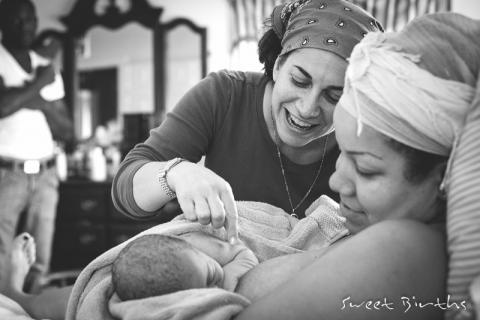
Safe for whom? Understanding how risk factors impact birth safety at home and birth centers
April 24, 2017
Research tells us that community birth (planned home and birth center births) is a safe option for low-risk women. But what does it mean to be low-risk? New research gives families and care providers data to help inform individual decisions about place of birth. I interviewed one of the researchers, Melissa Cheyney PhD, CPM, to learn more.
Jeanette McCulloch (JM): When a family is considering a birth in the community setting, they are typically told that home or birth center birth is a good option for low-risk, healthy mothers and babies. What does that mean?
Melissa Cheyney (MC): In all states and nations that support home and birth center birth as options for childbearing families, these services are generally described as appropriate for “low-risk,” healthy mothers and babies. However, there is actually very little agreement on what constitutes “low-risk.”
Also, the vast majority of research on risk factors in pregnancy has been conducted in hospitals within more medicalized approaches. As a result, we know very little about risk that is specific to home or birth center care led by midwives.
We designed this study to help begin to fill this gap. With the consent of the families receiving care, we have gathered nearly 50,000 cases of planned community birth. We now have sufficient numbers of women to be able to look with confidence at specific characteristics, like being over 35, having a body mass index over 30, or a breech positioned fetus, and examine how those factors influence risk.
JM: Are there any groups who have been told they might be “high-risk” in the past, but the new research tells us otherwise?
MC: Yes, certainly. Some of the risk factors we studied conferred lower amounts of risk than we had anticipated or than we might have guessed given current clinical guidelines for the care of these women.
For this research, we identified several risk factors (or what we call exposures) that we wanted to study. These included: primiparity (having your first baby), history of a prior cesarean (with or without a history of also having a vaginal birth), multiple pregnancy, breech presentation, gestational diabetes, preeclampsia, post-term pregnancy (greater than 42 weeks), advanced maternal age, and elevated body mass index. We also created a comparison group of those least likely to have poor outcomes regardless of setting: multiparous women (women who have already had one baby) who had no risk factors. Then we asked: how do these eight risk factors affect certain outcomes?
The outcomes we looked at were: likelihood of transfer, cesarean section, any genital tract trauma, any postpartum hospitalization for a maternal indication in the first 6 weeks, low 5-minute Apgar score (<7), very low 5-minute Apgar (<4), any neonatal hospitalization in the first 6 weeks, any NICU admission in the first 6 weeks and combined fetal and neonatal death. We combined fetal and neonatal death because these events were too rare to be analyzed alone.
Older than average mothers (35 years and older), women with an elevated BMI (30 and over) and women who labored after a cesarean who had also had a vaginal birth all had very little additional risk relative to our comparison group. Women who are older, heavier, or who have had a previous C-section and a vaginal birth who have no other complications actually do quite well in the community setting, and we are hopeful that state regulations will be modified to reflect these findings where needed.
JM: Can you tell us what the research tells about the risks of VBAC in the community setting?
MC: Yes, we learned that not all forms of labor after cesarean carry the same level of risk. Women who labored after a cesarean who had also had at least one vaginal birth had excellent outcomes in the community setting. In fact, their risk was lower than what we found for women having their first baby.
However, we also found that clients laboring after a cesarean who have not had a vaginal birth were at higher risk than anticipated. Their outcomes grouped among the highest risk of the subgroups we analyzed, which included breech and preeclampsia. Women laboring after a cesarean without a previous vaginal birth had a risk of fetal or neonatal death that was ten times higher than the low risk comparison group of healthy multiparous women with no risk factors. Their rate of fetal and neonatal death was 10 out of 1000 compared to a less than one out of 1000 among multiparous women with no risk factors.
To complicate matters, among women laboring after a cesarean with no prior vaginal birth, the repeat cesarean rate was just over 22%, which is less than our overall national cesarean rate of 32%. This means that 78% of women in this higher risk group had a vaginal birth! Pregnant people with this risk factor who are considering a community birth are forced to navigate a complex balance of risks and benefits associated with laboring after a cesarean in a community setting.
In addition, a previous study using these data also found that a higher proportion of women attempt to labor after a cesarean at home and in birth centers in regions of the US that have restrictive policies on vaginal birth after cesarean (VBAC) in the hospital. Taken together, our findings highlight the need to both decrease rates of primary cesarean section and to increase access to VBAC in the hospital.
JM: We know that repeat cesareans carry their own risks. How should a family balance the relative risk of very serious outcomes in the community setting with the rates of cesarean at their local hospital?
MC: That is really the crux of the issue, isn’t it? How do individual women and families balance risks when no one single option is truly risk free? I think it is important to start by affirming maternal autonomy in birth. The American College of Obstetrics and Gynecology (ACOG) is unequivocal in its position regarding maternal autonomy and the potential for maternal-fetal conflict. Pregnant people must receive accurate and complete information regarding the benefits, risks, and potential consequences of their choices. However, maternal autonomy should never be overridden, even when there is a high likelihood of fetal harm incurred by a mother’s choice.
It is also important to remember that when you are performing a study like this, you are working with very large numbers. Our study has 47,394 pregnancies. We need large sample sizes in order to have enough power to analyze the differences between groups. However, studies like this can never tell one individual woman what her risk will be or what path she should take, because any one woman can have mitigating or complicating factors that make her lower or higher risk than the category she would be placed in for the purposes of a study.
Practitioners will need to nuance these findings in their discussions with individual families. We can begin by giving families a broad sense of the risk landscape, but then the conversation will have to narrow back in, not only to the mother's individual risk profile, but also to her value system. It is her body, and until the baby is born, she has full autonomy in decision-making. She should be empowered to make choices about her own care that fit with her own or her community’s worldview and value systems. These findings are not directive. They provide tools for a conversation. This research provides far more data than we have ever had before that is specific to the community context to help guide these conversations.
JM: If an expectant parent is considering a community birth, what sorts of questions should they ask their provider?
MC: The most effective health care systems align the level of care provided to individual health care needs. “Health care needs” must also be understood to encompass more than just clinical needs; they should include individual and community values and preferences along with rights to autonomy, respect and cultural integrity. Care should be socially and culturally matched.
I would encourage families to explore the full range of options in their community. More and more communities are beginning to offer doula and midwifery services in the hospital, birth center care, and home birth. When families meet with community providers as they are considering options, I think it is important to ask about collaboration and mechanisms for transfer to a higher level of care should the need arise. Our study shows that when women have one or more of many of the risk factors we studied, the likelihood of transfer is higher. We know that all of these elements – respect, choice, integration and collaboration — play key roles in ensuring safety in the community setting.
JM: And what about families who don’t have a full range of options in their community?
MC: This is a major concern, and in fact, we see evidence of systematic discrimination in access to a range of care options in the very dataset we used for this study. When I first started working with data from the MANA Statistics Project, 92% of the mothers and babies represented were white. Now, in 2017, that number has dropped to 88%. That is a significant change for a five-year period, and is certainly a step in the right direction. It suggests that women of color in some areas are gaining more access to community care and/or that more midwives of color (who are more likely to care for clients of color) have begun contributing data.
However, I think it is dangerous to assume that underrepresentation in data sets means that women of color are not as interested in home or birth center care. Indeed, 25% of non-Hispanic, black women surveyed for Listening to Mothers III said they would select a home birth for their next birth. This suggests that home and birth center birth may currently be a white middle class phenomenon in the United States not because women of color prefer hospital birth, but because they have been systematically excluded from choice in childbearing by larger structures of inequality.
Photo credit: Sweet Births



The views and opinions expressed in this post are those of the author(s) and do not necessarily reflect those of MomsRising.org.
MomsRising.org strongly encourages our readers to post comments in response to blog posts. We value diversity of opinions and perspectives. Our goals for this space are to be educational, thought-provoking, and respectful. So we actively moderate comments and we reserve the right to edit or remove comments that undermine these goals. Thanks!